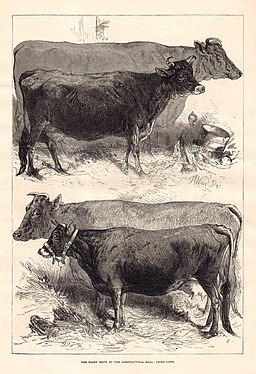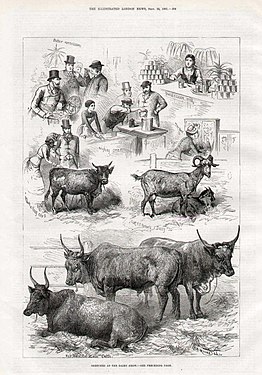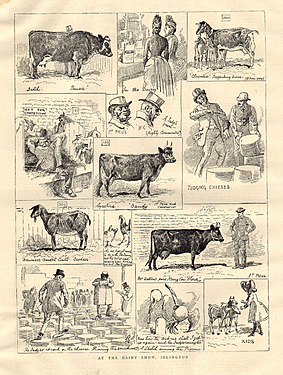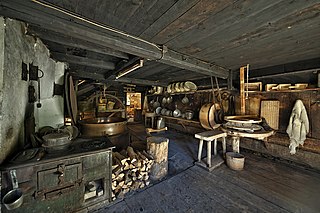
A dairy is a place where milk is stored and where butter, cheese and other dairy products are made, or a place where those products are sold. It may be a room, a building or a larger establishment. In the United States, the word may also describe a dairy farm or the part of a mixed farm dedicated to milk for human consumption, whether from cows, buffaloes, goats, yaks, sheep, horses or camels.

Animal husbandry is the branch of agriculture concerned with animals that are raised for meat, fibre, milk, or other products. It includes day-to-day care, management, production, nutrition, selective breeding, and the raising of livestock. Husbandry has a long history, starting with the Neolithic Revolution when animals were first domesticated, from around 13,000 BC onwards, predating farming of the first crops. During the period of ancient societies like ancient Egypt, cattle, sheep, goats, and pigs were being raised on farms.

William Dempster Hoard was an American politician, newspaper publisher, and agriculture advocate who served as the 16th governor of Wisconsin from 1889–1891. Called the "father of modern dairying", Hoard's advocacy for scientific agriculture and the expansion of dairy farming has been credited with changing Wisconsin's agricultural economy. He promoted the use of silos and alfalfa for cattle feed, testing for bovine tuberculosis, and single-use cattle herds in his magazine Hoard's Dairyman. His work with the Wisconsin Dairymen's Association led to the exporting of Wisconsin dairy products to the East Coast and those products earning national renown.

The Royal Agricultural Winter Fair (RAWF), also known as The Royal, is an annual agricultural fair that is held in Toronto, Ontario, Canada during the first two weeks of November. It was inaugurated in 1922 in the Coliseum, on the grounds of Exhibition Place. It has since been expanded to also take up the Enercare Centre and remains an important exhibit for livestock breeders. Elizabeth II, as Queen of Canada, was the fair's royal patron. Members of the Canadian Royal Family have also been guests of honour at the fair. It is the largest indoor agricultural fair in the world.

The Nigerian Dwarf is a modern American breed of dwarf goat. Like the American Pygmy Goat, it derives from the West African Dwarf group of breeds of West Africa.

Butter sculptures are three-dimensional works of art created with butter, a dairy product made from the fat and protein components of churned cream. The works often depict animals, people, buildings and other objects. They are best known as attractions at state fairs in the United States as lifesize cows and people, but can also be found on banquet tables and even small decorative butter pats. Butter carving was an ancient craft in Tibet, Babylon, Roman Britain and elsewhere. The earliest documented butter sculptures date from Europe in 1536, where they were used on banquet tables. The earliest pieces in the modern sense as public art date from ca. 1870s America, created by Caroline Shawk Brooks, a farm woman from Helena, Arkansas. The heyday of butter sculpturing was about 1890–1930, but butter sculptures are still a popular attraction at agricultural fairs, banquet tables and as decorative butter patties.

The Paris International Agricultural Show is an annual agricultural show and trade fair, that takes place at the end of February or beginning of March at the Paris expo Porte de Versailles in Paris, France. It is one of the world's largest and most important agricultural shows, drawing larger crowds than any other in Paris except the Foire de Paris.

The Maltese is a comparatively small sized rare breed of dairy goat known for its high milk production, high prolifacy and a resistance and adaptation to heat stress.

Dairy farming in New Zealand began during the early days of colonisation by Europeans. The New Zealand dairy industry is based almost exclusively on cattle, with a population of 4.92 million milking cows in the 2019–20 season. The income from dairy farming is now a major part of the New Zealand economy, becoming an NZ$13.4 billion industry by 2017.
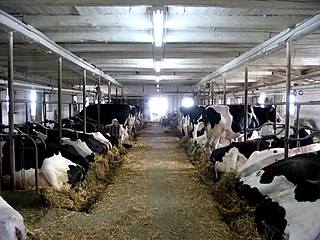
Dairy farming is one of the largest agricultural sectors in Canada. Dairy has a significant presence in all of the provinces and is one of the top two agricultural commodities in seven out of ten provinces.

Being a country that has a largely rural and agriculture-based industry, animal husbandry plays an important role in the economy of Pakistan and is a major source of livelihood for many farmers. Between 30 and 35 million people in Pakistan's current labour force are estimated to be engaged in livestock rearing. While the agricultural practice is prevalent throughout the entire country, it is more common in the fertile provinces of Punjab and Sindh, which are traditionally the main areas of agriculture and farming activity. In 2020, the livestock industry contributed 60.6% to overall agriculture and 11.7% to the GDP.

Agriculture in Wales has in the past been a major part of the economy of Wales, a largely rural country which is part of the United Kingdom. Wales is mountainous and has a mild, wet climate. This results in only a small proportion of the land area being suitable for arable cropping, but grass for the grazing of livestock is present in abundance. As a proportion of the national economy, agriculture is now much less important; a high proportion of the population now live in the towns and cities in the south of the country and tourism has become an important form of income in the countryside and on the coast. Arable cropping is limited to the flatter parts and elsewhere dairying and livestock farming predominate.

Teeswater Creamery is a dairy business in the town of Teeswater, Ontario, Canada. It is the oldest creamery in Ontario. Since 1981 it has been owned by the Gay Lea Foods Co-operative.
The Smithfield Show, formerly the Smithfield Club Cattle Show and later the Royal Smithfield Show, was an annual British agricultural show, organised by the Royal Smithfield Club. It was founded in 1799 and was first held at Wootton's Livery Stables in Dolphin Yard, Smithfield, London. From 1862 until 1938 it was held at the Agricultural Hall in Islington, London. From 1949 it was held at the Earl's Court Exhibition Centre in Earl's Court, London. The last show was held there in 2004; it was the last major livestock show in London.

Agriculture is a significant sector in Wisconsin's economy, producing nearly $104 billion in revenue annually. The significance of the state's agricultural production is exemplified by the depiction of a Holstein cow, an ear of corn, and a wheel of cheese on Wisconsin's state quarter design. In 2017 there were 64,800 farms in the state, operating across 14.3 million acres of land.

Johanne (Hanne) Ane Margrethe Nielsen was a Danish farmer who may have invented Havarti cheese. In the 1800s, Nielsen traveled around Europe to learn about cheesemaking. Her farm was named Havarthigaard and was close to Copenhagen. After returning from her travels, she developed the technique to create a new type of cheese. She was also a teacher, writer, and an accountant for the profit made from her butter and cheese. Her butter and cheese were served to royal families, including a cheese made with cumin that was served to King Christian IX of Denmark. She was denied membership of the Royal Danish Agricultural Society although she had sought the assistance of dairy scientist Thomas Segelcke. Despite being skeptical of female accountants, Segelcke included her accounting method in a book he published.
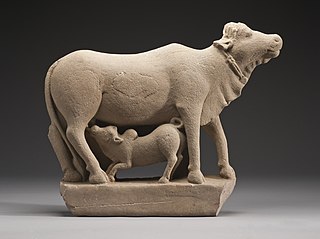
Dairy plays a significant part in numerous aspects of Indian society, including cuisine, religion, culture, and the economy.

Dairy is a major industry in the U.S. state of Wisconsin. Being known for its dairy production, the state is often called "America's Dairyland." The industry is prominent in official state symbols—being displayed on the state's license plates, state's slogan, and on the state quarter.
